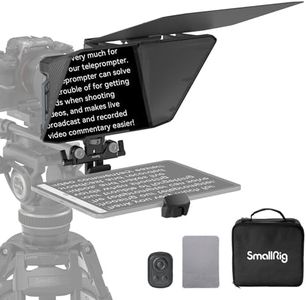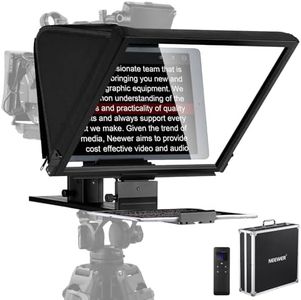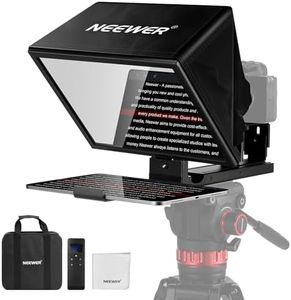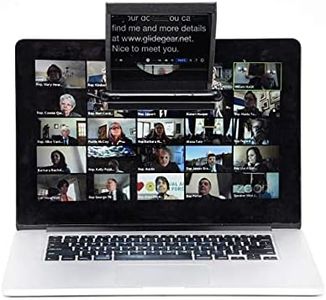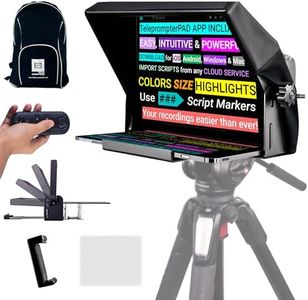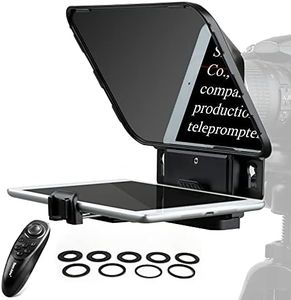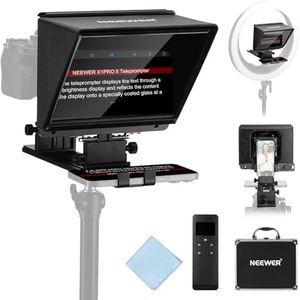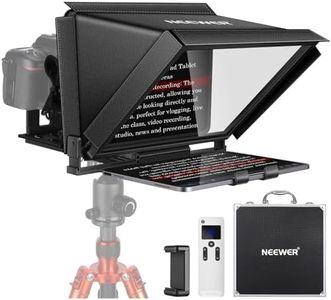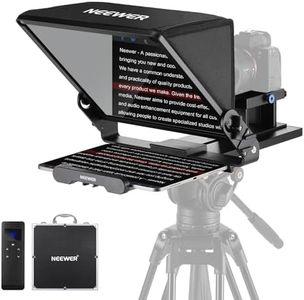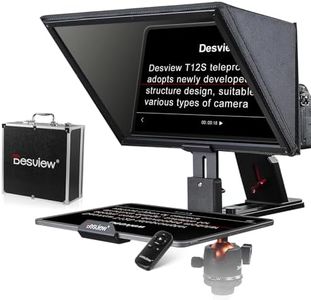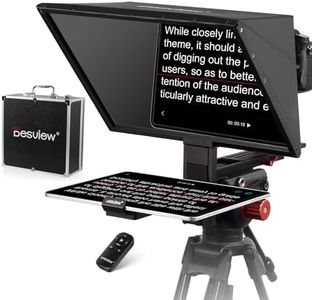We Use CookiesWe use cookies to enhance the security, performance,
functionality and for analytical and promotional activities. By continuing to browse this site you
are agreeing to our privacy policy
10 Best Teleprompters
From leading brands and best sellers available on the web.Buying Guide for the Best Teleprompters
Picking the right teleprompter can make presenting on-camera smoother and more professional, whether you’re recording in a studio, live streaming, or making content at home. The core idea of a teleprompter is simple: it displays your script while keeping your eye-line fixed on the camera lens, so you appear more natural and confident. To choose a teleprompter that suits your workflow, it's important to think about where and how you'll use it, the type of devices you already own (such as tablets, phones, or monitors), and the spaces in which you'll be filming. Let’s break down the main specs to guide your decision.Screen Size (Diagonal)Screen size is the measured diagonal distance across the reflective glass or display area where your script will show. It’s crucial because it affects how far you can stand from the teleprompter and still read the text comfortably. Smaller sizes (up to 10 inches) are lightweight and great for portable tabletop setups or close-up shots, but you need to be quite close to read the script. Medium sizes (10 to 15 inches) are good for most personal setups, offering versatility for both desk and tripod use. Large sizes (15 inches and above) are ideal if you plan to stand farther from the camera or want to use the teleprompter in larger studio spaces. Choose based on how far you want to stand from your camera and how big your typical text size is when reading comfortably.
Device CompatibilityDevice compatibility refers to the types of screens or devices that can be used to display your script on the teleprompter—often tablets, smartphones, or dedicated monitors. This matters because you’ll want a teleprompter that fits devices you already own, and it determines how easy it is to update and control your scripts. Some teleprompters support only certain sizes or brands of tablets/phones, while others have more adjustable trays or work best with a separate monitor via HDMI. Make sure the teleprompter can securely hold and fit your preferred device and check if its mounting system aligns with your workflow.
Mounting SystemThe mounting system is how the teleprompter attaches to your camera and tripod. It's important since it affects the setup’s stability and how quickly you can assemble or disassemble it. Some mount directly to a tripod and hold both the camera and teleprompter, while others sit in front of the camera lens on their own stand. Light, camera-top teleprompters are easier to move but usually handle smaller screens, whereas heavier units, which integrate both camera and teleprompter, offer a solid setup for longer filming. If you plan to move locations often or need to shoot with different cameras, choose a flexible, easy-to-attach system.
Glass Quality (Reflectivity and Coating)Teleprompter glass quality refers to the clarity and reflectivity of the special glass used. Teleprompters use a beam splitter glass that reflects the script but is invisible to the camera. Higher quality glass will display crisp text with little ghosting and won’t degrade your image. Look for teleprompters that mention being ‘optical-grade’ or ‘beam splitter’ glass with around 70/30 reflectivity (reflecting enough script text for the reader’s eyes while letting the camera capture the scene clearly). For most users, standard optical glass is fine, but if you’re doing high-end video or live broadcasts, prioritize the best glass to keep both text readability and video quality.
Script Control MethodScript control method describes how you scroll or advance your script text during recording. This can be manual—scrolling by hand, using an app on your device—or remote-controlled, where a Bluetooth or physical foot pedal lets you advance the text hands-free. If you need to change text speed or pause smoothly while filming, a remote or foot control is helpful, while beginners or those filming solo may be comfortable using basic manual controls. Consider your filming style and whether you often pause, redo takes, or interact with your script as you choose.
Portability and Build QualityPortability is about how easy it is to carry and set up your teleprompter, and build quality is about how sturdy and durable it feels. Lightweight, foldable teleprompters are handy for people who shoot in different locations or want an easy home-studio setup they can pack away. More robust builds are bulkier but last longer and can handle bigger devices and more frequent use. Think about how often you’ll move your teleprompter and whether it needs to survive travel or just stay in one place.
